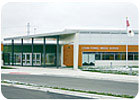
When a new School District 159 middle school was needed in Matteson, IL - located in Cook County among the south Chicago suburbs - topping the district’s list of priorities were enduring energy-saving value and ample learning opportunities that would prepare students for a global career marketplace. The district commissioned KJWW Engineering Co. (Naperville, IL) to perform an initial feasibility study and come up with a schematic design and recommendations for essential items including the heating and cooling system.
Going to the well
“The school district chose water source heat pumps (WSHPs) because - in addition to the district’s desire for the latest energy-efficient system - there was already a storm water-detention pond on the site the district had purchased,” said project manager Jerry Gillette of Globetrotters Engineering Corp. in Chicago. “So we expanded the pond to meet the required water source flow characteristics.”In fact, the pond - which is the source of the geothermal system’s water-to-water heat-exchange capability - also lends a certain esthetic appeal to Colin L. Powell Middle School. “I hired a consultant to perform the fluid mechanic studies and calculations for the required pond characteristics,” Gillette said. “Those calculations are based on water capacity and anticipated ambient temperatures at certain depths year-round.
“Obviously, you have to take both wintertime and summertime conditions into consideration. And we installed a groundwater well pump in case the level of the pond might fall so low during a potential drought that we’d need to pump more water in to fill the pond - which has to be maintained at a depth of approximately 14 ft to accommodate the system’s required flow.”
Looking beyond first cost
Jay Samuelsson of Imbert Corp., a commercial representative for ClimateMaster in the Chicago area, said that when dealing with WSHP systems, one of the largest oversights on the part of owners is the importance of funding. Because the systems require a higher initial investment, it’s essential to consider all of the various funding options available.The WSHP systems can represent substantial anticipated operating-cost savings over the life of the system, “But there can also be a lot of initial-cost resistance up front,” he said. For this project, the ClimateMaster WSHP’s higher initial cost was largely offset by a grant - awarded for energy-saving technology - from an Illinois electric-cooperative association.
The school district selected ClimateMaster DDC with DXM boards - tied into a larger BAS that controls lighting and all other electrical functions. Gillette also sees the WSHP as a further key ingredient in the total package.
“Often with heat pump systems in the Midwest, you have to provide for supplemental heat in the wintertime,” Gillette said. “We don’t think we’ll need that because we’re getting the heat source from the pond. And with the compressor inside the heat pump, we can do things that will extract enough heat so we don’t have to purchase additional heating capacity from the electrical utility. A 780 kW boiler serves as an emergency backup should the temperature drop to -40°F.
The finished product
Now completed, Colin L. Powell Middle School is 160,000 sq ft - with 82 ClimateMaster WSHP units installed. The project involves total capacity of 280 tons (985 kW) of water-to-air and 180 tons (633 kW) of water-to-water heat pumps - with outside air energy recovery air-handlers adding to the overall efficiency. And Gillette is quick to point out that that’s not all - that the overall package really sold the deal.“One of the biggest points in favor of using this type of system is the fact that in each classroom, the teacher controls the climate,” Gillette said. “Not only is there a thermostat in each room, but the zoning is such that there’s a dedicated heat pump that does both heating and cooling for each individual classroom.
“We also gain a maintenance advantage from the standpoint of isolation of the zones. With a traditional VAV system, for example, one unit will often handle more than one room - making it more complex to deal with conflicting requirements in the different rooms than we have with this water-source heat pump system.”
Expected annual operating-cost savings using the WSHP system are estimated at around $70,000, or about 60% compared to a conventional system. “It’s really a win/win all around,” Gillette said. “The school district is going to benefit. The students and their parents are going to benefit from a more favorable climate in the academic environment. And a 7-yr payoff is actually very good for an investment in major cutting-edge equipment such as this.”
